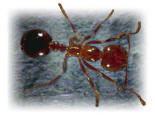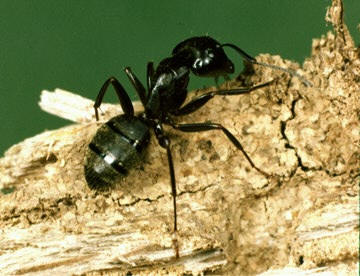ANTS
Fire ants are stinging ants of the
genus Solenopsis, of which there are over 280 species and
subspecies worldwide. Most species are unobtrusive, and rarely come into contact
with humans, and of the few that do, most do not attain the status of serious
pests, as they are kept in check by parasites and predators, as well as
competition with other ants. However, at least one species, Solenopsis
invicta, commonly known as the Red imported fire ant (RIFA), has been moved
around the world from its native range in So uth
America and, in the absence of its predators and parasites, has become a major
pest nearly everywhere it has been introduced, as
is common for invasive species. This species was accidentally introduced into
the United States via Brazilian cargo entering the port of Mobile, Alabama, in
the 1930s. The ants have since spread from coastal areas of Alabama and now
infest large parts of the U.S. South, creating a nuisance to farmers and
homeowners alike from California to Maryland. Since 2001, this species has been
spread to eastern Australia, the Philippines, Taiwan, and China.
uth
America and, in the absence of its predators and parasites, has become a major
pest nearly everywhere it has been introduced, as
is common for invasive species. This species was accidentally introduced into
the United States via Brazilian cargo entering the port of Mobile, Alabama, in
the 1930s. The ants have since spread from coastal areas of Alabama and now
infest large parts of the U.S. South, creating a nuisance to farmers and
homeowners alike from California to Maryland. Since 2001, this species has been
spread to eastern Australia, the Philippines, Taiwan, and China.
A typical Solenopsis colony
produces large mounds in open areas, and feeds primarily on young plants and
seeds. Solenopsis often attacks small animals and can kill them. Unlike
many other ants, which bite and then spray formic acid on the wound, fire ants
only bite to get a grip and then sting (from the abdomen) and inject a toxic
alkaloid venom. For humans this is a painful sting - hence the name fire ant -
and the after effects of the sting can be deadly to sensitive individuals. The
worker ants are blackish to reddish and vary from 3-6 mm in length. The
diagnostic feature for the genus Solenopsis is the possession of a single
median seta on the anterior clypeal margin.
Carpenter ants are large, black
ants (1/4" - 1") indigenous to large parts of the world. They prefer dead, damp
wood in which to build nests. Sometimes carpenter ants will hollow out sections
of trees. The Carpenter Ant is one of the more de structive
pests found in homes. Colonies that remain undetected and untreated can grow to
as large as 8,000 workers and can cause severe structural damage. Contrary to
popular belief, Carpenter Ants do not actually eat the wood. They remove it,
leaving smooth holes and halls through the wood. Small inexplicable piles of
shavings similar to pencil shavings below windows or below openings in
baseboards are one possible sign of an infestation. Locating and eliminating the
actual colony is the only way to effectively treat this problem.
structive
pests found in homes. Colonies that remain undetected and untreated can grow to
as large as 8,000 workers and can cause severe structural damage. Contrary to
popular belief, Carpenter Ants do not actually eat the wood. They remove it,
leaving smooth holes and halls through the wood. Small inexplicable piles of
shavings similar to pencil shavings below windows or below openings in
baseboards are one possible sign of an infestation. Locating and eliminating the
actual colony is the only way to effectively treat this problem.
All ants in this genus possess an obligate
bacterial endosymbiont called Blochmannia. This bacterium has a small
genome, and retains genes to biosynthesize essential amino acids and other
nutrients. This suggests the bacterium plays a role in ant nutrition. Many
Camponotus species are also infected with Wolbachia, another
endosymbiont that is widespread across insect groups.
HOME
 uth
America and, in the absence of its predators and parasites, has become a major
pest nearly everywhere it has been introduced, as
is common for invasive species. This species was accidentally introduced into
the United States via Brazilian cargo entering the port of Mobile, Alabama, in
the 1930s. The ants have since spread from coastal areas of Alabama and now
infest large parts of the U.S. South, creating a nuisance to farmers and
homeowners alike from California to Maryland. Since 2001, this species has been
spread to eastern Australia, the Philippines, Taiwan, and China.
uth
America and, in the absence of its predators and parasites, has become a major
pest nearly everywhere it has been introduced, as
is common for invasive species. This species was accidentally introduced into
the United States via Brazilian cargo entering the port of Mobile, Alabama, in
the 1930s. The ants have since spread from coastal areas of Alabama and now
infest large parts of the U.S. South, creating a nuisance to farmers and
homeowners alike from California to Maryland. Since 2001, this species has been
spread to eastern Australia, the Philippines, Taiwan, and China. structive
pests found in homes. Colonies that remain undetected and untreated can grow to
as large as 8,000 workers and can cause severe structural damage. Contrary to
popular belief, Carpenter Ants do not actually eat the wood. They remove it,
leaving smooth holes and halls through the wood. Small inexplicable piles of
shavings similar to pencil shavings below windows or below openings in
baseboards are one possible sign of an infestation. Locating and eliminating the
actual colony is the only way to effectively treat this problem.
structive
pests found in homes. Colonies that remain undetected and untreated can grow to
as large as 8,000 workers and can cause severe structural damage. Contrary to
popular belief, Carpenter Ants do not actually eat the wood. They remove it,
leaving smooth holes and halls through the wood. Small inexplicable piles of
shavings similar to pencil shavings below windows or below openings in
baseboards are one possible sign of an infestation. Locating and eliminating the
actual colony is the only way to effectively treat this problem.